Tennessee is home to many species from other regions of the world. Many of these are invasive. They can have negative effects on the native populations and can cause damage to their habitats, as well as causing problems for humans.
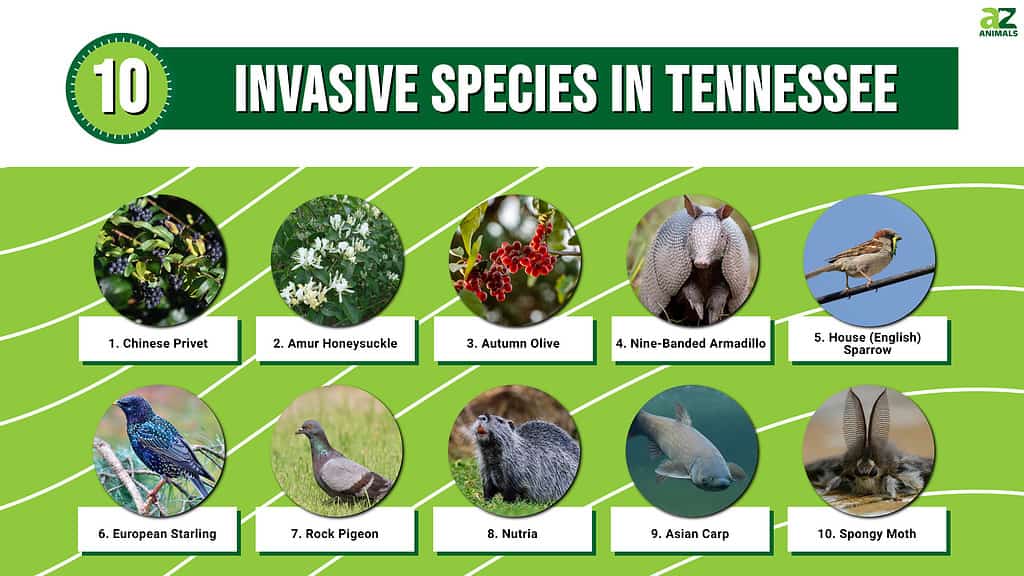
Let’s look at 10 of these species that have invaded Tennessee.
1. Chinese Privet (Ligustrum sinense Lour.)
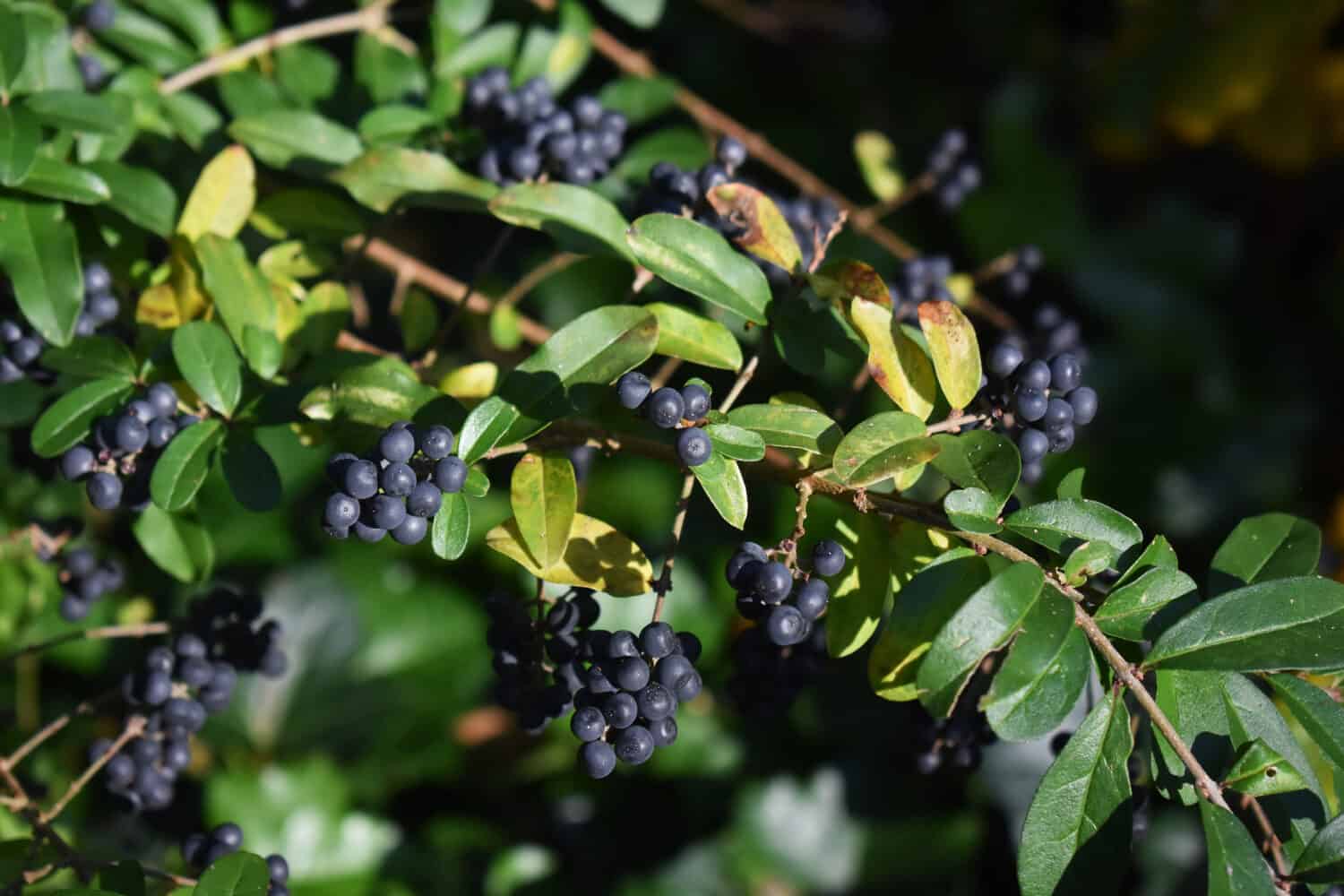
Chinese privet is an invasive plant species from China with oval leaves, blackberries, and small white flowers.
©Gabriela Beres/Shutterstock.com
Originating in China and introduced to many countries across the world, Chinese privet made its way to Tennessee in the early to mid-1800s. This hardy plant can grow up to 16 feet tall and has smooth greyish-tan bark. It is evergreen with oval leaves, blackberries, and clusters of small white flowers. The main reason for its introduction to areas outside of China is for hedging.
Chinese privet is invasive in many of the regions it has spread to, including Tennessee. Reasons for its invasive classification include: crowding native plants and competing for growing space, providing minimal ecological benefit, and degradation of riverbanks and streams. It can grow and spread very quickly, further adding to its environmental harm and difficulties in management.
The most practical method for controlling Chinese privet is not planting it in the first place. However, for more established clusters of the plant, control methods include cutting it down and using a herbicide to kill it completely. Pulling out fresh saplings or completely digging out the plants are also effective methods.
2. Amur Honeysuckle (Lonicera maackii)

Native to eastern Asia, amur honeysuckle is a large shrub that can prevent native shrubs from growing.
©APugach/Shutterstock.com
Amur honeysuckle is native to eastern Asia. It is an invasive species in the woodlands of the United States. It was introduced to New York in 1898 as an ornamental plant. The amur honeysuckle is a large shrub that can grow up to 20 feet tall with stems up to 4 inches in diameter. The leaves are long and broad. The amur honeysuckle produces its flowers in pairs. They are three-quarters of an inch long, white at first, and then turn yellow or pale orange in color. The fruit produced is red to black and contains many seeds dispersed through birds.
The amur honeysuckle is an invasive species in Tennessee because it negatively affects the diversity of the ecosystems and the regeneration of woodlands. The growth and diversity of native seedlings are reduced because of this invasive species. This plant can form dense thickets and prevent the growth of native shrubs, specifically in deciduous woodlands.
Control methods include mechanical and chemical measures. You can pull young plants by hand. You must cut larger plants repeatedly or pull them using a tool. Also, you can apply herbicides to foliage, bark, or cut stems to prevent growth.
3. Autumn Olive (Elaeagnus umbellata)
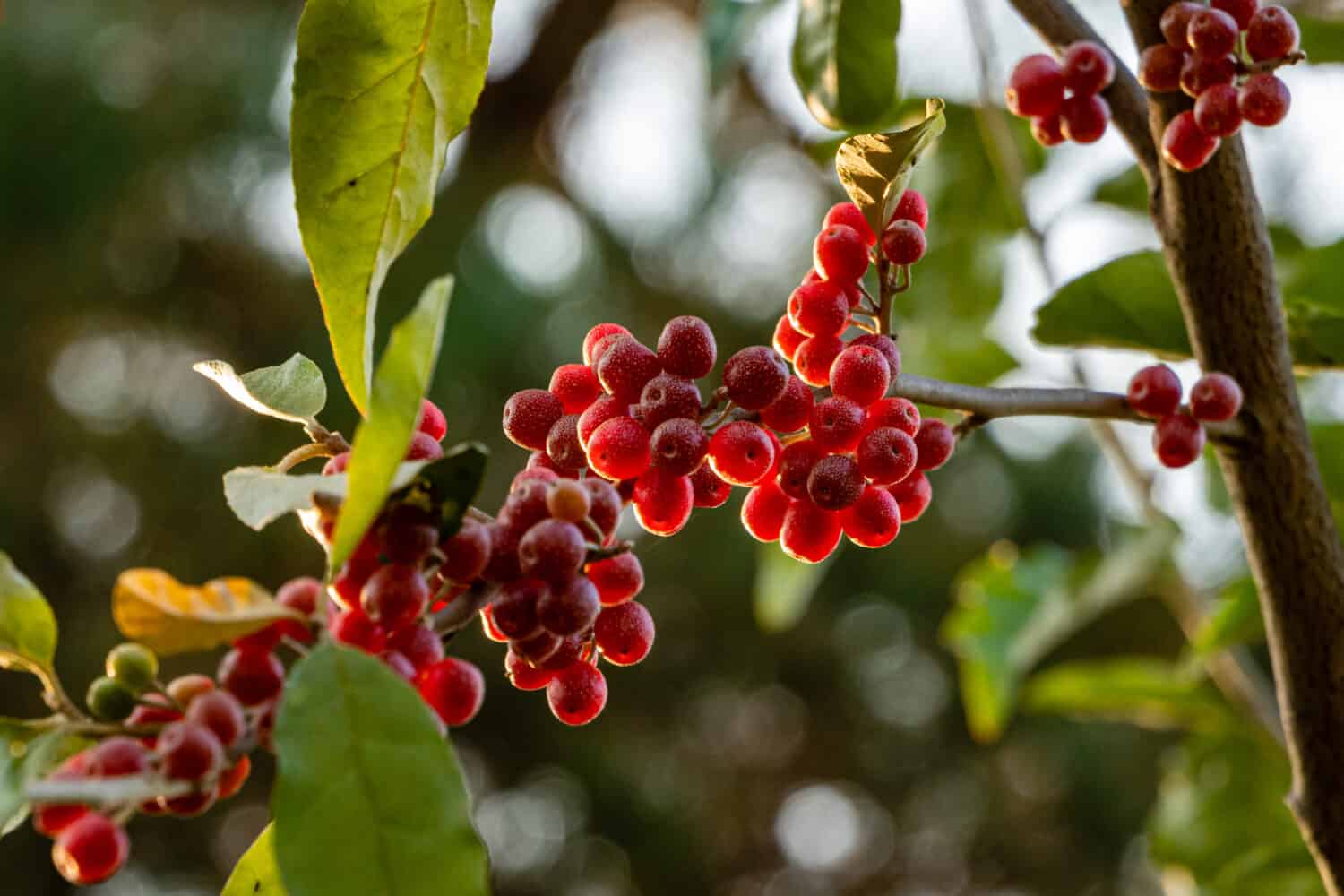
Introduced to the USA in 1830, the autumn olive shades out other plant species and changes the soil chemistry.
©Alexander Denisenko/Shutterstock.com
Autumn olive is a shrub native to eastern Asia introduced to the United States in 1830 for its ornamental, windbreak, and restoration properties. It is medium to large-sized and is an extremely hardy plant. The autumn olive can grow up to 11 feet tall with a dense crown and sharp thorns. The flowers produced are white to yellow, and the fruit is red with dots. This fruit is juicy and round – a delicious treat for many birds and animals.
The autumn olive is considered an invasive species in Tennessee. This is because the plant outcompetes and displaces native flora. The plant also shades out other species of plants and changes the soil chemistry as well. Autumn olive easily spreads into other areas as the birds that eat the fruit disperse the seeds. As autumn olive is a hardy plant that can grow in barren conditions, it is incredibly difficult to control.
Control measures are a necessity to control this invasive plant. Mechanical measures, chemical measures, and a combination of the two are used to control the spread of this plant. The most effective method is to use a combination of mechanical and chemical measures. An example of mechanical measures is cutting the autumn olive at its main stem. An example of chemical measures is using herbicides to prevent resprouting.
4. Nine-Banded Armadillo (Dasypus novemcinctus)

This nocturnal insectivore has a lack of natural predators and a high reproductive rate.
©guentermanaus/Shutterstock.com
The nine-banded armadillo is a mammal native to South America. Now, these creatures can be found in North and Central America, including Tennessee. This species of armadillo weighs between 5.5 and 14.3 lbs. Their bodies are around 15 to 23 inches long, while their tail is 10 to 21 inches long. These mammals can easily be identified by their armor covering the back, sides, head, tail, and outer surfaces of the limbs. This armadillo is named as such because of the nine bands found on the animal.
The nine-banded armadillo lives in scrublands, open prairies, and tropical rainforests. These animals do prefer a warm and rainy environment and cannot thrive in cold or dry environments. They are nocturnal and are generally insectivores that feed on grubs, beetles, ants, millipedes, and more. They use their claws to dig the ground to find their prey. The nine-banded armadillo has been furthering and expanding its range due to a lack of natural predators within the United States and a high reproductive rate.
Unfortunately, the nine-banded armadillo’s feeding activity causes damage to locations such as laws, gardens, sports fields, and more. They can also cause structural instabilities when they dig burrows around buildings. Another reason this creature is considered invasive in Tennessee is because of the growing armadillo population – this means that there is an increased frequency of contact between them and humans. This is a concern because the nine-banded armadillo can host the bacteria that causes leprosy.
Not only does the nine-banded armadillo cause damage and threat, but there are also no control methods that are effective and sustainable. There are no repellents or toxicants that can be used for armadillos. A tactic that has been used to reduce armadillo damage is removing the food they are known to eat using insecticides. This method, however, can have negative side effects on other species and the environment. It is legal to hunt and kill these creatures at any time in Tennessee.
5. House (English) Sparrow (Passer domesticus)

These tiny birds are aggressive and will compete with native species for both food and nesting sites.
©Werner Baumgarten/Shutterstock.com
The house sparrow originated from Eurasia and Northern Africa. They were introduced into Brooklyn in the mid-1800s and, by 1910, had established themselves throughout America, including Tennessee. They are small birds with a streaked brown back and greyish underbelly with thick sharp beaks. House sparrows can grow up to 6.25 inches in length and weigh just under 1 ounce.
House sparrows are rapid breeders, often laying and hatching 4 to 5 chicks per season. This helps their numbers to grow very quickly, requiring more space for them to live while displacing native bird populations. These sparrows are aggressive towards other species, especially native nesting birds. They will forcibly evict them from their nests and build their own nest on top of it. This aggressiveness that these birds express is part of what makes them considered an invasive species in Tennessee. Furthermore, the house sparrows compete with local native species for food and nesting sites.
Thankfully, however, the house sparrow numbers have been declining in recent years, especially in urban and suburban areas. There are several effective control methods in use in Tennessee to reduce the population of these invasive birds, including modifying nest box openings to be less than 0.75 inches in diameter. This prevents the sparrows from entering the nest and protects the native occupants. Other control methods include trapping of the live birds, and nest removal which tends to discourage the birds from building again.
6. European Starling (Sturnus vulgaris)
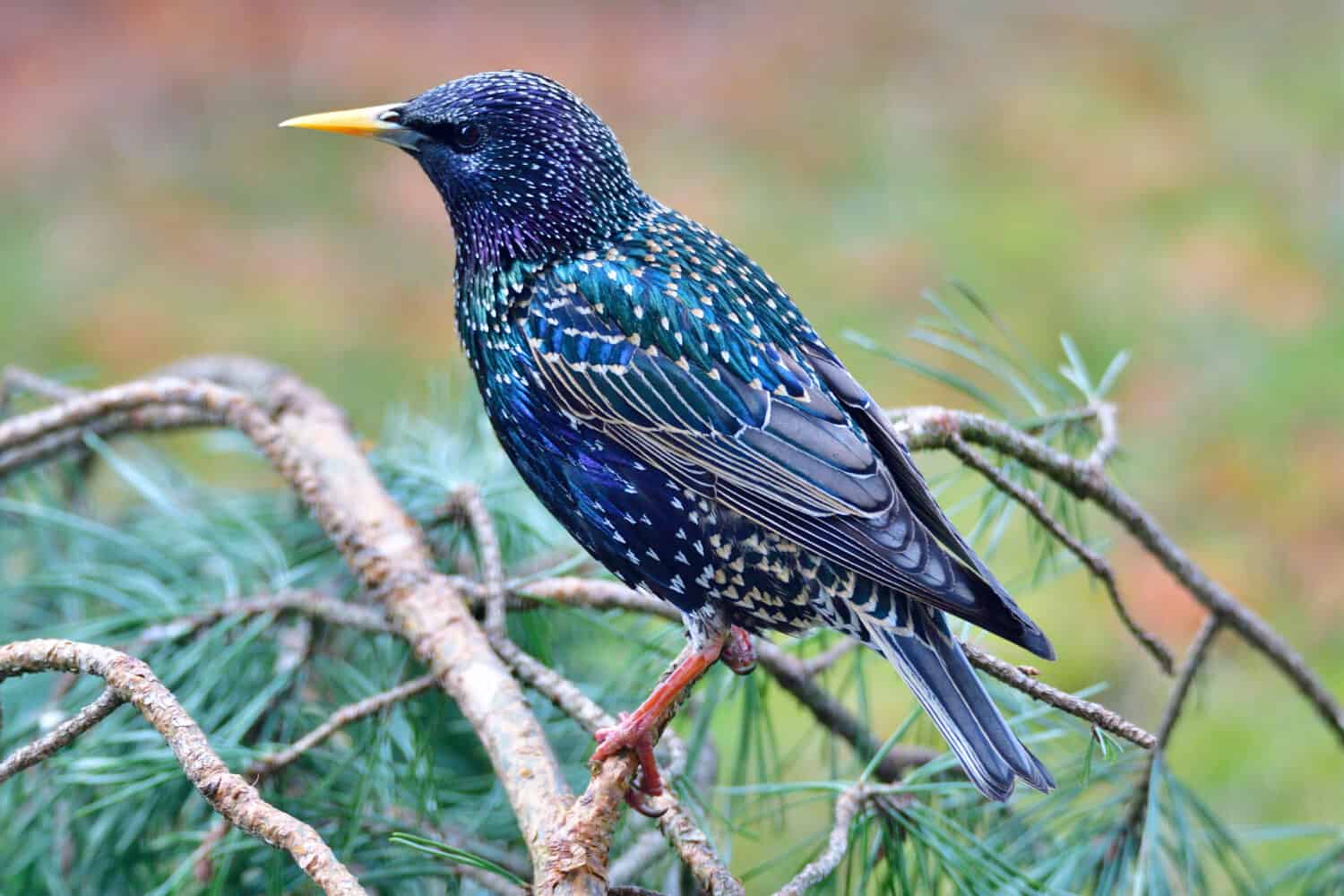
Native to Europe, European starlings outcompete native birds for food and nesting sites.
©Karin Jaehne/Shutterstock.com
The European starling is a bird native to Europe and parts of Asia and Africa. These birds were introduced to New York in 1890 and have since spread throughout the United States. These birds are not large and weigh only between 0.13 and 0.22 pounds and are only 8.5 inches long. The European starling is black and stocky. The coloring of the bird changes depending on the season. During the fall, they are black with glossy green accents with white speckles. However, in the winter, they lose these white speckles. The beak of the European starling is sharp and brownish-yellow in color.
European starlings are an invasive species in Tennessee because they outcompete native birds for food and nesting sites. The European starlings are very aggressive and will destroy eggs and kill nestlings of other bird species. These birds can also cause damage to crops and gardens as they have a large appetite. The European starling is also extremely adaptable, allowing them to adapt to new habitats and thrive. Lastly, these birds can form huge swarms, which can cause disruption.
Control methods for the European starling include trapping and chemicals. Trapping can be very effective, especially over large areas. Chemical repellents can be used to deter the birds from consuming or damaging fruit.
7. Rock Pigeon (Columba livia)

Although not a major threat to native bird species, rock pigeons are a nuisance to humans.
©Opasbbb/Shutterstock.com
Rock pigeons were introduced to North America in the early 1600s and have become the most widely studied bird in the world. They are native to Eurasia and North Africa, where they were domesticated as pets and for food. The rock pigeon is a medium-sized bird with a length of around 12.5 inches and can weigh upwards of 9 ounces. They come in a variety of colorations, with the most common being grey with iridescent plumage around the neck.
The rock pigeon is omnivorous, and its diet mainly comprises seeds and small insects. In the cities, however, they will forage on a variety of food scraps such as breadcrumbs or even popcorn.
Unlike most invasive species in Tennessee, rock pigeons are not a major threat to native species because they do not compete for the same food sources or nesting sites. However, they are a huge nuisance to humans due to the large amounts of droppings that accumulate in populated areas. These droppings can harbor diseases that can negatively affect the health of humans who come in close contact with the matter.
Control methods to minimize the congregation of rock pigeons in public areas of Tennessee include using spikes along roof ridges, netting set in rafters or under roofs, or other barriers in places where the birds may want to roost. There are no protection or hunting laws regarding the killing of these birds. Pest control is a common method to remove persistent flocks from public areas.
8. Nutria (Myocastor coypus)
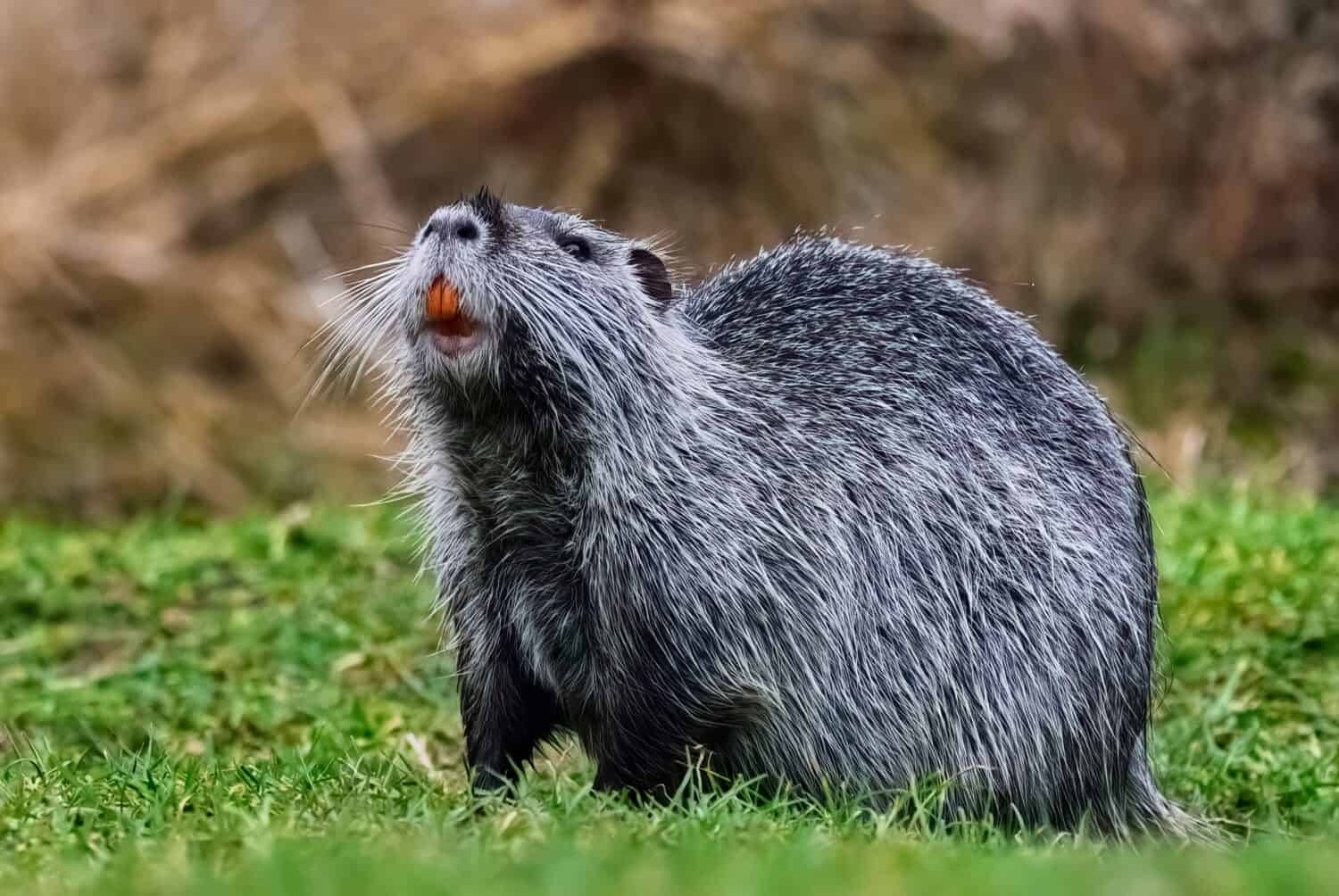
Nutria cause damage to lakes, riverbanks, and levees.
©Robert Adami/Shutterstock.com
More commonly known as the river rat, the nutria is a semi-aquatic rodent originating from South America. They were brought to Louisiana in the 1930s and have since spread to Tennessee. They are large rodents weighing between 15 and 20 pounds, and when fully grown, they can reach 30 to 42 inches in length. Their fur is dark brown, with a lighter shade on their underside. They have small front legs and larger hind legs, with partially webbed back feet.
Nutria are herbivores that eat the vegetation on the land and in the water. Cattails, reeds, and sedges are among their favorite foods.
Nutria are an invasive species in Tennessee due to the damage they cause to lakes, riverbanks, and levees, causing erosion through their eating, digging, and rooting habits. They will also feed on native plant life, causing a decline in vegetation. Not only do they cause damage to the environment, but they are also hosts for pathogens capable of infecting humans.
Methods used to minimize the damage that these rodents cause include using wire tubes to protect certain plants and installing bulkheads to protect eroding river banks. Where these methods fail to produce results, more lethal actions are used to reduce the population of these invasive animals.
9. Asian Carp (Bighead Carp, Silver Carp, Black Carp, Grass Carp) (Hypophthalmichthys nobilis, Hypophthalmichthys molitrix, Mylopharyngodon piceus, Ctenopharyngodon idella)
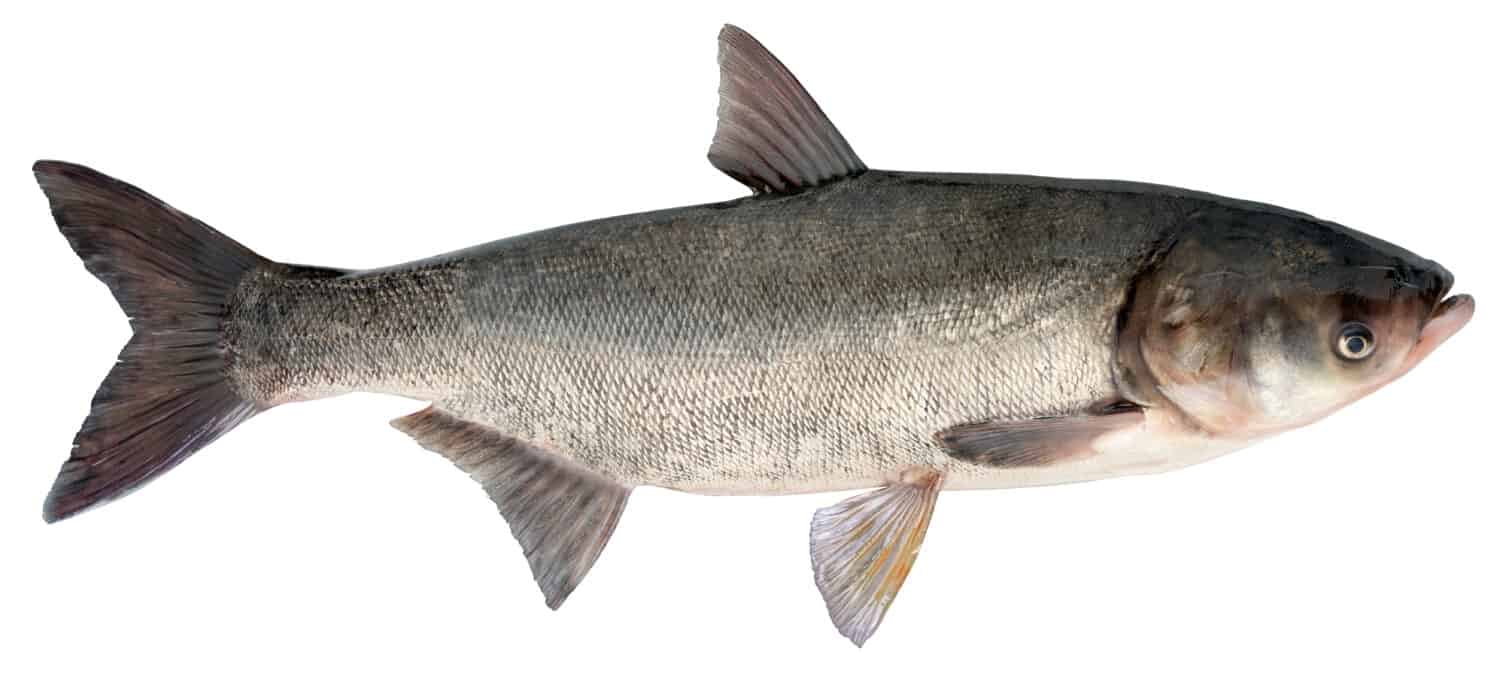
There are many types of Asian carp, including the silver carp (pictured above).
©Edvard Ellric/Shutterstock.com
The carp is a freshwater fish native to Asia and it became introduced to the United States in 1970. These fish are large and generally weigh anywhere between 10 to 15 lbs but can weigh up to 90 lbs in some cases. The carp is generally between 18 and 30 inches long but can grow up to 4 feet. Depending on the type of Asian carp, the coloring of this fish can vary from dark gray and cream to brown, black, olive brown, and silver.
The diet of the Asian carp depends on the species. The bighead carp feeds on zooplankton and invertebrates and outcompetes native species for food. The black carp feeds on zooplankton, mollusks, shrimp, crawfish, and insects – these also outcompete native species for food. Grass carp feed on aquatic plants but also consume insects, detritus, and fish. The grass carp can significantly alter the composition of the habitat. This is because they reduce food sources, shelter, and spawning areas for native fish. The silver carp feed on phytoplankton and outcompete native fish juveniles.
The Asian carp are an invasive species in Tennessee not only because they outcompete native fish for food and shelter but also because they reproduce quickly and consume up to 40% of their body weight in food every day. Lastly, the silver carp occasionally jump out of the water and cause injury to boaters. In Tennessee, the most practical method to reduce Asian carp is commercial fishing. Commercial fishing has the potential to remove millions of pounds of carp annually.
10. Spongy Moth (Lymantria dispar)

With a diet consisting of deciduous trees, the spongy moth can cause damage leading to deforestation.
©HWall/Shutterstock.com
The spongy moth is an insect formerly known as the gypsy moth. This insect is native to Europe, Asia, and North Africa and was introduced to the United States in 1869. The spongy moth is actually America’s most destructive invasive insect! Female spongy moths are much larger than male spongy moths and have a wingspan between 2.3 and 3.5 inches, while males have a wingspan of around 1.5 inches. Females are flightless and are creamy-white in color with darker zig-zag patterns. Males can fly and are greyish-brown with black markings. Female spongy moths have thin antennae, and males have feather-like antennae.
The spongy moth’s diet mainly consists of deciduous trees. The damage that this insect can cause can cause mass deforestation. This means other species that rely on the forests for food and shelter will be negatively affected. Unfortunately, spongy moth populations have surged in East Tennessee. Because of the damage spongy moths cause to the environment, population growth must be disrupted.
A common control method to reduce spongy moth populations is the application of the spongy moth mating pheromone. This reduces the ability of the male spongy moth to find and mate with a female spongy moth. This method is effective and has no known impact on humans or other wildlife.
Summary of 10 Invasive Species in Tennessee
| # | Invasive Species | Origin |
|---|---|---|
| 1 | Chinese Privet | China |
| 2 | Amur Honeysuckles | Eastern Asia |
| 3 | Autumn Olive | Eastern Asia |
| 4 | Nine-Banded Armadillo | South America |
| 5 | House Sparrow | Eurasia, Northern Africa |
| 6 | European Starling | Europe, Asia, Africa |
| 7 | Rock Pigeon | Eurasia, Northern Africa |
| 8 | Nutria | South America |
| 9 | Asian Carp | Asia |
| 10 | Spongy Moth | Europe, Asia, North Africa |
The photo featured at the top of this post is © HWall/Shutterstock.com
Thank you for reading! Have some feedback for us? Contact the AZ Animals editorial team.






